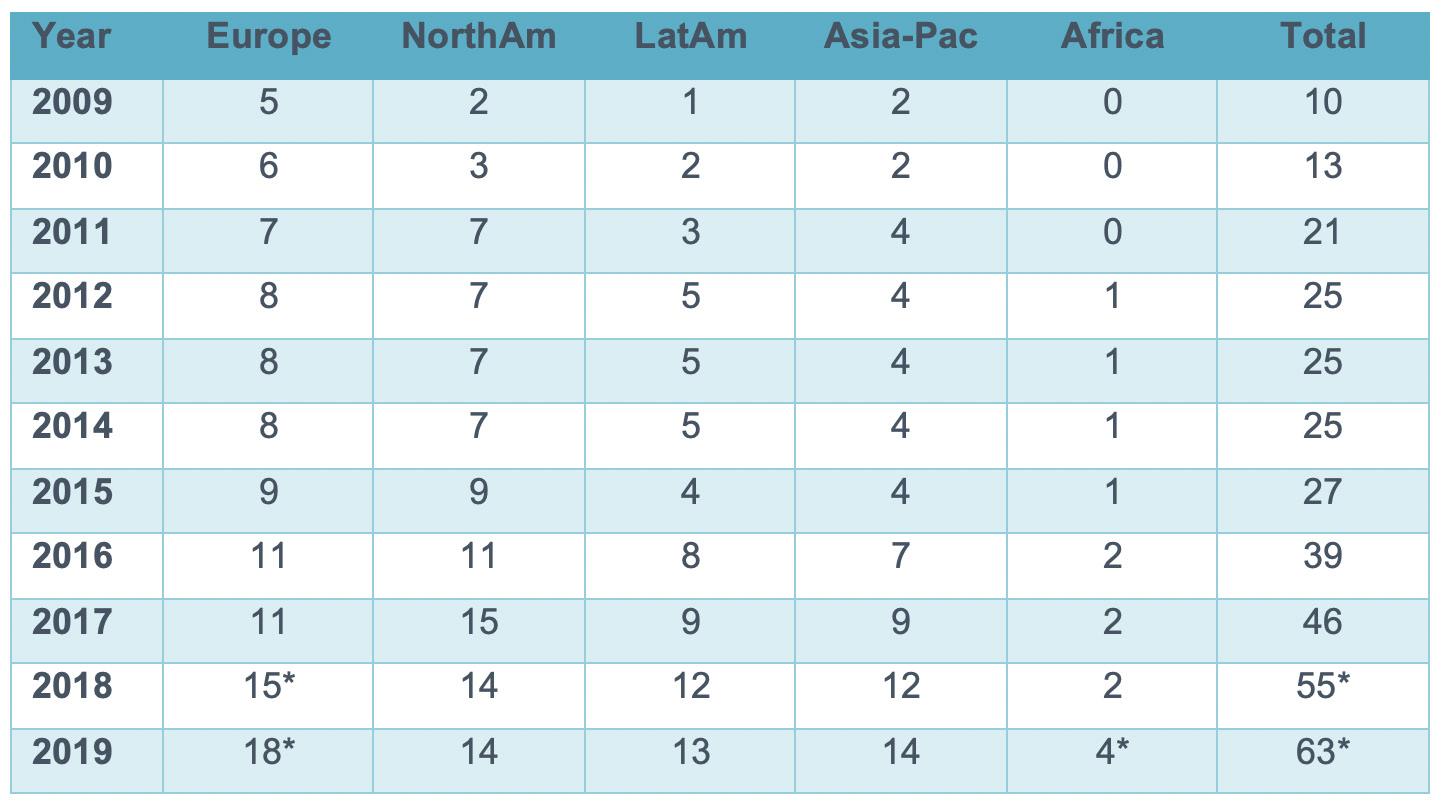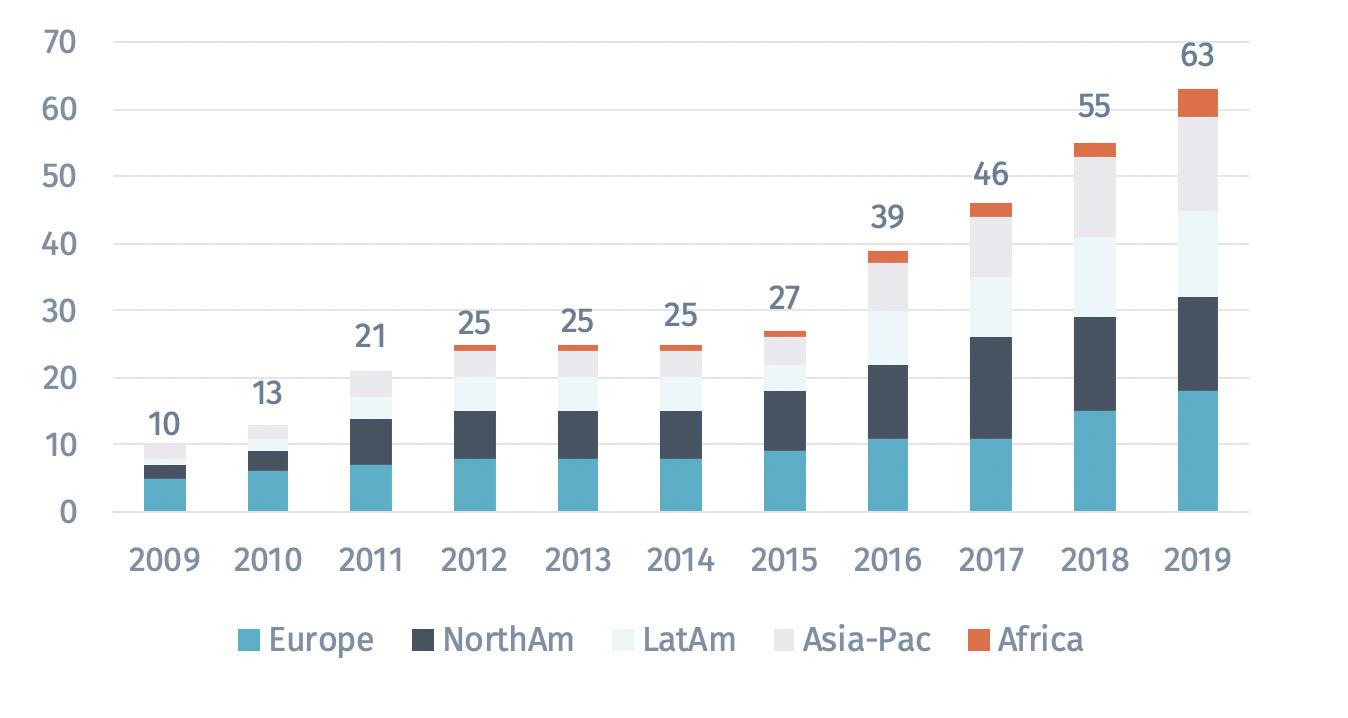
4 minute read
Members
The GABV membership has radically changed since its first annual report in 2014. During the last 10 years, the GABV has focused not only on growing its members base, but also on achieving a more geographically balanced composition of its membership.
The regional distribution of GABV membership shifted in 2018 and through September 2019 with faster growth in Europe and Asia-Pacific. Together these regions account for 50.8% of GABV members. Intra-regional diversity increased both in terms of new members’ business models (e.g. local and national cooperatives) and countries of origin (India, Philippines, Japan, Honduras, Colombia and Russia, to name a few).
Advertisement
During 2019, the GABV welcomed eight new members and associate members. The regional distribution of GABV membership in 2019 is presented in Figure 1.1, while Figure 1.2 shows regional membership since 2009.
(*) These numbers include associate members (1 in 2018 and 4 in 2019, 2 in Europe and 2 in Africa)

GABV members and associates in 2019, by region (in %)

GABV member list as December 2019
Alternative Bank Switzerland (Switzerland) Amalgamated Bank (USA) Banca Etica (Italy. Spain) Banco Ademi (Dominican Republic) Banco de Antigua (Guatemala) Banco FIE (Bolivia) Banco Mundo Mujer (Colombia) Banco Popular (Honduras) Banco Solidario (Ecuador) Bancompartir (Colombia) BancoSol (Bolivia) BANFONDESA (Dominican Republic) Bank Australia (Australia) Muamalat Bank (Malaysia) Bank of Palestine (Palestine) Beneficial State Bank (USA) BRAC Bank (Bangladesh) Caisse d’économie solidaire Desjardins (Canada) Caja Arequipa (Peru) CARD Bank, Inc. (Philippines) Centenary Bank (Uganda) Center-Invest Bank (Russia) Charity Bank (UK) 1 City First Bank of DC (USA) Clearwater Credit Union (USA) Cooperativa Abaco (Peru) Cooperative Bank of Karditsa (CBK) (Greece) Crédit Coopératif (France) Cultura Bank (Norway) DAI-ICHI KANGYO Credit Cooperative (DKC) (Japan) Decorah Bank and Trust Co. (USA) Ecology Building Society (United Kingdom) Ekobanken (Sweden) ESAF Small Finance Bank (India) FolkeSparekassen (Denmark) Freie Gemeinschaftsbank Genossenschaft (Switzerland) GLS Bank (Germany) Grooming Microfinance Bank (Nigeria) 1 Kindred Credit Union (Canada) LAPO Microfinance Bank (Nigeria) Lead Bank (USA) MagNet Bank (Hungary) MegaBank (Ukrania) 1 Merkur Resource Bank (Denmark) Muktinath Bikas Bank Ltd. (Nepal) National Cooperative Bank (USA) NMB Bank Limited (Nepal) North East Small Finance Bank (India) Opportunity Bank (Serbia) Opportunity Savings and Loans (Ghana) 1 SAC Apoyo Integral, S.A. (El Salvador) Southern Bancorp (USA) Sunrise Banks (USA) Teachers Mutual Bank (Australia) The First Microfinance Bank Afghanistan (Afghanistan) The First Microfinance Bank Tajikistan (Tajikistan) Triodos Bank (Europe) UmweltBank (Germany) Vancity (Canada) Verity CU (USA) Vision Banco (Paraguay) VSECU (Vermont State Employees Credit Union) (USA) XacBank (Mongolia)
1Triple Bottom Line Approach
1Triple Bottom Line Approach 2 Real Economy
Triple bottom line approach at the heart of the business model.
Values-based banks integrate this approach by focusing simultaneously on people, planet and prosperity. Products and services are designed and developed to meet the needs of people and safeguard the environment. Generating reasonable profit is recognized as an essential requirement of values-based banking but is not a stand-alone objective. Importantly, values-based banks embrace an intentional approach to triple-bottom-line business – they don’t just avoid doing harm, they actively use finance to do good.
Triple Bottom Line Approach 3 Client Centred
Grounded in communities, serving the real economy and enabling new business models to meet the needs of both.
Values-based banks serve the communities in which they work. They meet the financial needs of these geographic and sector-based communities by financing enterprises and individuals in productive and sustainable economies.
Long-term relationships with clients and a direct understanding of their economic activities and the risks involved.
Values-based banks establish strong relationships with their clients and are directly involved in understanding and analyzing their economic activities and assisting them to become more valuesbased themselves. Proper risk analysis is used at product origination so that indirect risk management tools are neither adopted as a substitute for fundamental analysis nor traded for their own sake.
GABV Annual Report 2019 Triple Bottom Line Approach 5 Transparency
Long-term, self-sustaining, and resilient to outside disruptions.
Values-based banks adopt a long-term perspective to make sure they can maintain their operations and be resilient in the face of external disruptions. At the same time, they recognize that no bank, or its clients, is entirely immune to such disruptions.
T riple Bottom Line Approach 6 Culture
Transparent and inclusive governance.
Values-based banks maintain a high degree of transparency and inclusiveness in governance and reporting. In this context, inclusiveness means an active relationship with a bank’s extended stakeholder community, and not only its shareholders or management.
All of these principles embedded in the culture of the bank.
Values-based banks seek to embed these principles in the culture of their institutions so that they are routinely used in decision-making at all levels. Recognizing that the process of embedding these values requires deliberate effort, these banks develop human resources policies that reflect their values-based approach (including innovative incentive and evaluation systems for staff) and develop stakeholderoriented practices to encourage values-based business models. These banks also have specific reporting frameworks to demonstrate their financial and non- financial impact.








